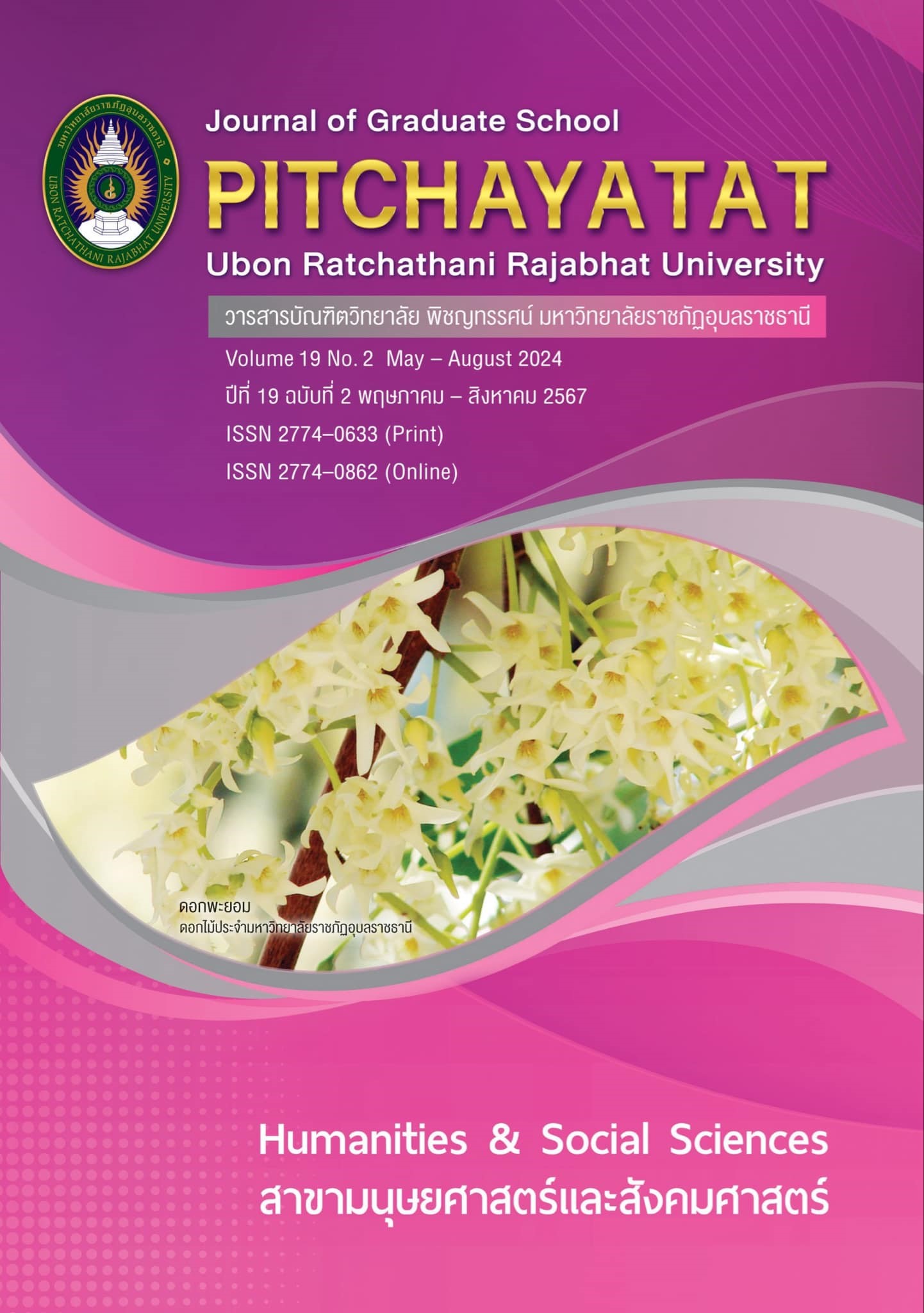ภูมิปัญญาศิลปกรรมเครื่องแต่งกายโนราภาคใต้
คำสำคัญ:
ภูมิปัญญา , ศิลปกรรมท้องถิ่น , เครื่องแต่งกายโนรา , การพัฒนาผลิตภัณฑ์บทคัดย่อ
งานวิจัยนี้มีวัตถุประสงค์เพื่อ 1) ศึกษาภูมิปัญญาท้องถิ่นศิลปกรรมเครื่องแต่งกายโนราภาคใต้ 2) ศึกษาความต้องการของชุมชนและสภาพปัญหาในการพัฒนาผลิตภัณฑ์ภูมิปัญญาศิลปกรรมเครื่องแต่งกายโนราภาคใต้ และ 3) เพื่อการพัฒนาผลิตภัณฑ์ศิลปกรรมเครื่องแต่งกายโนราภาคใต้ พื้นที่วิจัยในจังหวัดพัทลุงและจังหวัดสงขลา การวิจัยครั้งนี้ใช้วิธีวิจัยเชิงคุณภาพ ด้วยวิธีศึกษาเอกสารและเก็บข้อมูลภาคสนามโดย การสำรวจ สัมภาษณ์ สังเกต สนทนากลุ่ม และอบรมเชิงปฏิบัติการ จากกลุ่มผู้ให้ข้อมูลจำนวน 50 คน ได้เสนอผลการวิจัยแบบพรรณนาวิเคราะห์
ผลการวิจัยพบว่า
- ภูมิปัญญาท้องถิ่นศิลปกรรมเครื่องแต่งกายโนรา มีความคล้ายคลึงกัน นิยมใช้ลูกปัดร้อยประกอบกันเป็นเครื่องแต่งกายอย่างหลากหลาย มีลวดลายสวยงามแตกต่างกันตามความต้องการของผู้แสดง
- ความต้องการของชุมชนในการที่จะเข้าร่วมโครงการเสริมสร้างอาชีพทางเครื่องแต่งกายโนรา ประชาชนในพื้นที่วิจัย สามารถนำภูมิปัญญาศิลปกรรมเครื่องแต่งกายโนรามาสร้างสรรค์พัฒนาผลิตภัณฑ์และประดิษฐ์ลูกปัดได้หลายรูปแบบ ได้ เป็นการสร้างงานที่มีต้นทุนการผลิตต่ำได้ผลกำไรที่คุ้มค่า ทั้งนี้สภาพปัญหาในการพัฒนาผลิตภัณ์ศิลปกรรมเครื่องแต่งกายโนราภาคใต้มีสาเหตุมาจาก 3 ด้านประกอบด้วย (1) ด้านระยะเวลาในการประดิษฐ์ (2) ด้านการสืบทอดภูมิปัญญา และ (3) ด้านรายได้
- การพัฒนาผลิตภัณฑ์ศิลปกรรมเครื่องแต่งกายโนราภาคใต้ พบว่า มีขั้นตอนการพัฒนาผลิตภัณฑ์ 3 ขั้น (1) การศึกษาภูมิปัญญาท้องถิ่นโนราภาคใต้ (2) การกำหนดและออกแบบแก้ไขและแบบทดสอบเบื้องต้น (3) ออกแบบผลิตภัณฑ์ใหม่โดยการมีส่วนร่วมของชุมชนในการออกแบบ ซึ่งผู้เข้าร่วมอบรมสามารถพัฒนาผลิตภัณฑ์ได้ 4 ประเภท ได้แก่ (1) พวงกุญแจแบบยาว (2) พวงกุญแจแบบกลม (3) สร้อยคอที่มีระย้า และ (4) สร้อยข้อมือ
เอกสารอ้างอิง
คณะกรรมการวัฒนธรรมแห่งชาติ, สำนักงาน. ภูมิปัญญาชาวบ้านกับการพัฒนาชนบท. กรุงเทพฯ: อัมรินทร์ พริ้นติ้งกรุ๊ฟ, 2534.
ทรงคุณ จันทจร. การถ่ายทอดภูมิปัญญาชาวบ้านในเรื่องทรัพยากรดิน น้ำ ป่าไม้ของกลุ่มชาติพันธุ์กะเลิง. มหาวิทยาลัยมหาสารคาม: สถาบันวิจัยศิลปะและวัฒนธรรมอีสาน มหาสารคาม, 2549.
ธวัช ปุณโณทก. ภูมิปัญญาชาวบ้านอีสาน. กรุงเทพฯ: เจริญวิทย์การพิมพ์, 2534.
บุปผาชาติ อุปถัมภ์นรากร. การอนุรักษ์การพัฒนาและการสืบสานศิลปะการแสดงภาคใต้. วิทยานิพนธ์ปรัชญาดุษฎีบัณฑิต มหาวิทยาลัยมหาสารคาม, 2552.
ประพนธ์ เรืองณรงค์. การศึกษาและอนุรักษ์วัฒนธรรมพื้นบ้านภาคใต้ในปัจจุบันในพื้นบ้าน พื้นเมือง-ถิ่นไทยทักษิณ. กรุงเทพฯ: โรงพิมพ์อมรินทร์การพิมพ์, 2534.
พิทยา บุษรารัตน์. ตำนานโนรา: ความสัมพันธ์ทางสังคมและวัฒนธรรมบริเวณลุ่มทะเลสาบสงขลา. สงขลา: มหาวิทยาลัยทักษิณ, 2537.
ยศ สันตสมบัติ. มนุษย์กับวัฒนธรรม. กรุงเทพฯ: มหาวิทยาลัยธรรมศาสตร์, 2537.
วิรุณ ตั้งเจริญ. สุนทรียศาสตร์เพื่อชีวิต. กรุงเทพฯ : มหาวิทยาลัยธรรมศาสตร์, 2537.
สุธิวงศ์ พงศ์ไพบูลย์. “โครงสร้างและพลังวัฒนธรรมทางการเมืองและการปกครองในภาคใต้,” วารสารทักษิณคดี, 2, 2 ( กรกฎาคม 2542): 162-176.
สุรเชษฐ์ เวชชพิทักษ์. รากฐานแห่งชีวิต : วัฒนธรรมทางการพัฒนา. กรุงเทพฯ: หมู่บ้าน, 2533.
เอกวิทย์ ณ ถลาง. ภาพรวมภูมิปัญญาไทย. พิมพ์ครั้งที่ 2. กรุงเทพฯ: อมรินทร์, 2544.
เอกวิทย์ ณ ถลาง และคณะ. ภูมิปัญญาท้องถิ่นกับการจัดการความรู้. กรุงเทพฯ: อมรินทร์, 2546.
Choi, S.H. and H.H. Cheung. “Multi-material virtual prototyping for product development and biomedical engineering,” Computers in Industry. 58, 5 (2007) : 438-452.
Kanno, Tetsuya. An Institutional Anlysis of the Commercial Viability of two Weaing Project in Northeast Thailand. Master s Thesis Khonlaen University, 1997.
Maslow, A.H. "A Theory of Human Motivation," Psychological Review. 50, 4 (1943): 370-394.
ดาวน์โหลด
เผยแพร่แล้ว
รูปแบบการอ้างอิง
ฉบับ
ประเภทบทความ
สัญญาอนุญาต
ลิขสิทธิ์ (c) 2024 วารสารบัณฑิตวิทยาลัย พิชญทรรศน์ มหาวิทยาลัยราชภัฏอุบลราชธานี

อนุญาตภายใต้เงื่อนไข Creative Commons Attribution-NonCommercial-NoDerivatives 4.0 International License.
บทความทุกเรื่องได้รับการตรวจความถูกต้องทางวิชาการโดยผู้ทรงคุณวุฒิภายนอกอย่างน้อย 2 คน ความคิดเห็นในวารสารบัณฑิตวิทยาลัย พิชญทรรศน์ มหาวิทยาลัยราชภัฏอุบลราชธานี เป็นความคิดเห็นของผู้เขียนมิใช่ความคิดเห็นของผู้จัดทำ จึงมิใช่ ความรับผิดชอบของบัณฑิตวิทยาลัย มหาวิทยาลัยราชภัฏอุบลราชธานี และบทความในวารสารบัณฑิตวิทยาลัย พิชญทรรศน์ มหาวิทยาลัยราชภัฏอุบลราชธานี สงวนสิทธิ์ตามกฎหมายไทย การจะนำไปเผยแพร่ต้องได้รับอนุญาตเป็นลายลักษณ์อักษรจากกองบรรณาธิการ






